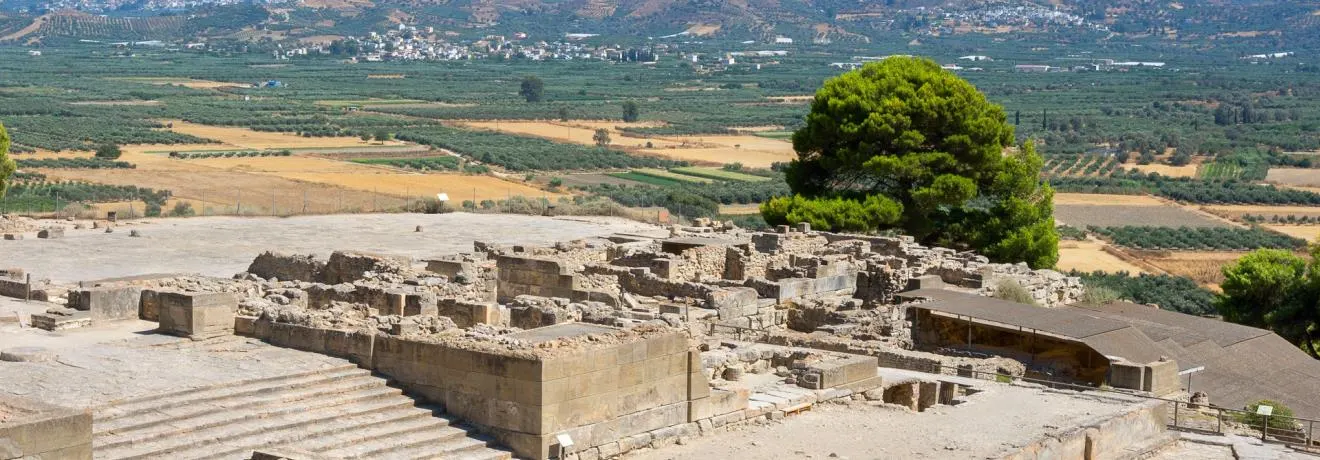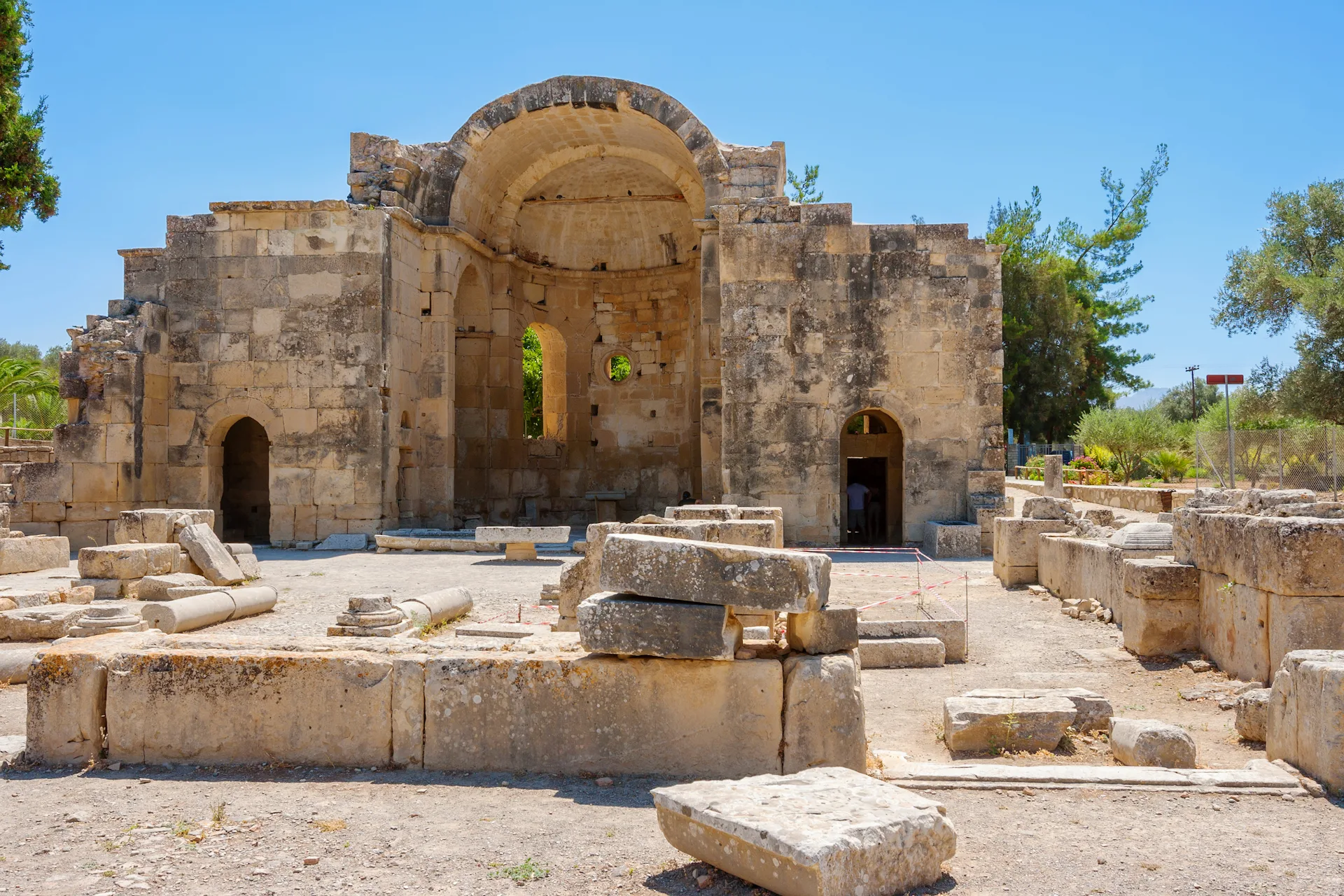Check availabilities
Our fleet is one of the most variable to be found, including:


Explore the Palace of Festos with a rental car from Autocreta
The History of Festos Palace
Situated on a hill overlooking the fertile Messara Plain in southern Crete, Festos Palace was once a thriving Minoan center. The palace was first built around 1900 BCE, during the peak of the Minoan civilization, and was later destroyed and rebuilt around 1700 BCE, possibly due to an earthquake. Festos was ultimately abandoned around 1450 BCE, coinciding with the decline of the Minoan civilization.
Festos Archeological Palace was first excavated in the early 20th century by Italian archaeologist Federico Halbherr, who uncovered a wealth of artifacts, including the famous Phaistos Disk. The palace is now an open-air museum, inviting visitors to explore its well-preserved ruins and rituals of the Minoans.


Architectural Features of Festos Palace
Like other Minoan palaces, Festos Palace was designed around a central courtyard and features an intricate layout of interconnected rooms, corridors, and staircases. The palace's architecture showcases the Minoans' skillful use of space, light, and natural materials such as limestone, gypsum, and alabaster.
Some of the most notable features of Festos Palace include:
1. The West Court: The main entrance to the palace, the West Court was a large open space used for ceremonies and gatherings.
2. The Grand Staircase: A monumental, wide staircase that led from the West Court to the upper floor of the palace.
3. The Royal Apartments: Located on the upper floor, these rooms were likely reserved for the palace's elite residents and included private living quarters, a throne room, and a lustral basin used for ritual purification.
4. The Central Court: An expansive courtyard at the heart of the palace, which may have been used for religious ceremonies, performances, or other public events.
5. The Theatral Area: Situated on the east side of the palace, this open-air space featured tiered seating and may have been used for performances or other gatherings.
 The Mystery of the Phaistos Disk
The Mystery of the Phaistos Disk
One of the most intriguing discoveries at Festos Palace is the Phaistos Disk, a small clay disk dating back to around 1700 BCE. The disk is covered with mysterious, undeciphered symbols arranged in a spiral pattern, which has puzzled scholars for decades.
While numerous theories have been proposed regarding the disk's purpose and meaning, from a religious text to a board game, the true nature of the Phaistos Disk remains a captivating enigma.
While numerous theories have been proposed regarding the disk's purpose and meaning, from a religious text to a board game, the true nature of the Phaistos Disk remains a captivating enigma.
Visiting Festos Palace
Festos Palace is located approximately 62 km south of Heraklion, Crete's capital city, and is easily accessible by car or public transportation. The site is open year-round, with an entrance fee required for visitors. In addition to exploring the palace's ruins, visitors can enjoy stunning panoramic views of the surrounding landscape and visit the nearby archaeological site of Agia Triada, another important Minoan settlement.
The Palace of Festos offers a fascinating journey into the world of the ancient Minoans, showcasing their remarkable architectural achievements, cultural practices, and artistic prowess. As you wander through the palace's ruins and marvel at its intricate design, you can't help but be transported back in time to the height of the Minoan civilization. Festos Palace is not only an essential destination for history enthusiasts but also a captivating experience for anyone seeking to delve deeper into the rich heritage of Crete.
Nearby Attractions
While visiting Festos Palace, consider exploring the surrounding area, which boasts a variety of attractions that further illuminate Crete's diverse history and natural beauty. Some of these attractions include:

Agia Triada: Just a few kilometers from Festos, the archaeological site of Agia Triada features the ruins of a Minoan villa and a royal villa. The site is home to beautifully preserved frescoes, pottery, and other artifacts, offering another glimpse into the Minoan way of life.
Kommos Beach: After exploring the ancient sites, unwind at Kommos Beach, a beautiful sandy beach located along the southern coast of Crete. The beach is an ideal spot for swimming, sunbathing, or enjoying a seaside meal at one of the local tavernas.
Matala Beach: A short drive from Festos, Matala Beach is famous for its unique sandstone caves, which were once inhabited by Neolithic settlers and later became a haven for hippies in the 1960s. The beach offers crystal-clear waters, golden sands, and a rich history that makes it a popular destination for travelers.
Gortyna: Another significant archaeological site in the region, Gortyna was once a prosperous Roman city and the capital of Crete during the Roman and Byzantine periods. The site features extensive ruins, including a basilica, a theater, and the famous Gortyn Code, an ancient legal code inscribed on stone slabs.
By including these attractions in your itinerary, you can gain a deeper appreciation for the diverse historical, cultural, and natural treasures that Crete has to offer. Festos Palace and its surrounding sites are sure to leave a lasting impression, providing unforgettable memories of your journey through Crete's ancient past.





